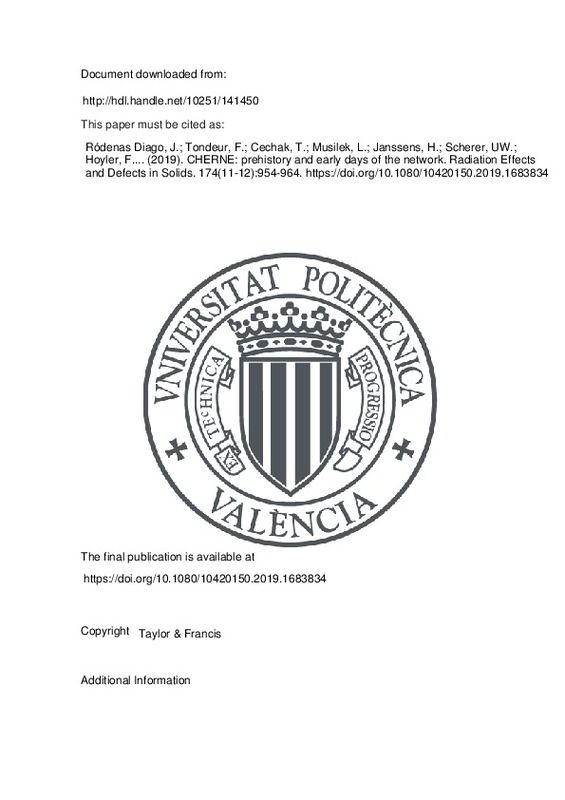JavaScript is disabled for your browser. Some features of this site may not work without it.
Buscar en RiuNet
Listar
Mi cuenta
Estadísticas
Ayuda RiuNet
Admin. UPV
CHERNE: prehistory and early days of the network
Mostrar el registro sencillo del ítem
Ficheros en el ítem
| dc.contributor.author | Ródenas Diago, José
|
es_ES |
| dc.contributor.author | TONDEUR, FRANÇOIS
|
es_ES |
| dc.contributor.author | Cechak, Tomas
|
es_ES |
| dc.contributor.author | Musilek, Ladislav
|
es_ES |
| dc.contributor.author | Janssens, Herwig
|
es_ES |
| dc.contributor.author | Scherer, Ulrich W.
|
es_ES |
| dc.contributor.author | Hoyler, Friedrich
|
es_ES |
| dc.contributor.author | Mostacci, Domiziano
|
es_ES |
| dc.date.accessioned | 2020-04-24T07:13:59Z | |
| dc.date.available | 2020-04-24T07:13:59Z | |
| dc.date.issued | 2019 | es_ES |
| dc.identifier.issn | 1042-0150 | es_ES |
| dc.identifier.uri | http://hdl.handle.net/10251/141450 | |
| dc.description.abstract | [EN] While the founding members of CHERNE gradually retire, the memory of the early steps of the network should not be lost. CHERNE (`Cooperation for Higher Education on Radiological and Nuclear Engineering¿) is the product of a specific Erasmus activity possible in the early 2000s: the intensive programmes (IP). The first step was a collaboration of three partners (Czech Technical University CTU, Institut Supérieur Industriel de Bruxelles ISIB, Universitat Politècnica de València UPV) organising in 2002 the 3-year IP `PAN: Practical Approach to Nuclear techniques¿, soon integrating two other partners (Aachen University of Applied Science AcUAS, XIOS Hogeschool Limburg). A second IP `SPERANSA: Stimulating Practical Expertise in RAdiation and Nuclear SAfety¿ was first organised without Erasmus support in 2005. A workshop was held in 2005 at UPV, including colleagues from other universities. Its main goal was to put in contact professors and researchers from European Institutions in order to share experiences in education and research in Radiation Protection and Nuclear Engineering. The creation of an informal group of universities to develop activities for the benefit of students was discussed. With the addition of Università degli Studi di Bologna (UniBo) to the initial group, the CHERNE network was created. It attracted rapidly more members (6 adhesions in 2006). CHERNE was conceived as a non-formal wide-scope open network, easily integrating new members, offering affordable activities to the students and mostly relying on Erasmus subsidies. The main goal was still the organisation of Erasmus IP¿s based on practical activities, benefitting of the access to big experimental facilities offered by several partners, like reactors, accelerators, or a radiochemical laboratory. SPERANSA was organised from 2006 to 2008, `JUNCSS: JÜlich Nuclear Chemistry Summer School¿ from 2007 to 2011 and `RAPIX-NOCOS: Radiation protection in non-conventional sectors¿ in 2007 and 2008 without Erasmus support. The annual workshops triggered exchanges between partners and attracted more institutions. The first workshops saw intense discussions about the network organisation and the types of activities that could be organised. A kind of maturity was reached from 2008. | es_ES |
| dc.language | Inglés | es_ES |
| dc.publisher | Taylor & Francis | es_ES |
| dc.relation.ispartof | Radiation Effects and Defects in Solids | es_ES |
| dc.rights | Reserva de todos los derechos | es_ES |
| dc.subject | Erasmus | es_ES |
| dc.subject | Intensive programme | es_ES |
| dc.subject | Network | es_ES |
| dc.subject | Nuclear engineering | es_ES |
| dc.subject | Radiation protection | es_ES |
| dc.subject.classification | INGENIERIA NUCLEAR | es_ES |
| dc.title | CHERNE: prehistory and early days of the network | es_ES |
| dc.type | Artículo | es_ES |
| dc.identifier.doi | 10.1080/10420150.2019.1683834 | es_ES |
| dc.rights.accessRights | Abierto | es_ES |
| dc.contributor.affiliation | Universitat Politècnica de València. Departamento de Ingeniería Química y Nuclear - Departament d'Enginyeria Química i Nuclear | es_ES |
| dc.description.bibliographicCitation | Ródenas Diago, J.; Tondeur, F.; Cechak, T.; Musilek, L.; Janssens, H.; Scherer, UW.; Hoyler, F.... (2019). CHERNE: prehistory and early days of the network. Radiation Effects and Defects in Solids. 174(11-12):954-964. https://doi.org/10.1080/10420150.2019.1683834 | es_ES |
| dc.description.accrualMethod | S | es_ES |
| dc.relation.publisherversion | https://doi.org/10.1080/10420150.2019.1683834 | es_ES |
| dc.description.upvformatpinicio | 954 | es_ES |
| dc.description.upvformatpfin | 964 | es_ES |
| dc.type.version | info:eu-repo/semantics/publishedVersion | es_ES |
| dc.description.volume | 174 | es_ES |
| dc.description.issue | 11-12 | es_ES |
| dc.relation.pasarela | S\408149 | es_ES |







![[Cerrado]](/themes/UPV/images/candado.png)

